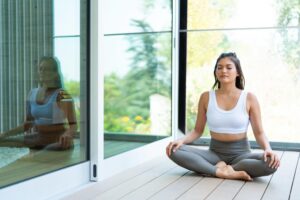In today’s fast-paced world, where stress and anxiety seem to be constant companions, the need for relaxation has never been more vital.
Yoga, a centuries-old practice, offers a sanctuary of tranquility amidst the chaos. In this article, we will explore how yoga can be a powerful tool for relaxation, providing both physical and mental rejuvenation.
The Power of Yoga for Relaxation
Yoga is more than just a physical exercise; it is a holistic approach to well-being that encompasses the body, mind, and spirit.
When it comes to relaxation, yoga’s effectiveness lies in its ability to soothe the nervous system, release physical tension, and quiet the mind. Here’s how yoga achieves this:
1. Breath Control (Pranayama): The foundation of relaxation in yoga is controlled breathing. Techniques like deep diaphragmatic breathing, also known as “pranayama,” can calm the nervous system and reduce stress. Practices like “Nadi Shodhana” (alternate nostril breathing) are particularly effective for relaxation.
2. Gentle Asanas (Yoga Poses): Certain yoga poses are specifically designed to relax the body. Poses like “Balasana” (Child’s Pose), “Savasana” (Corpse Pose), and “Supta Baddha Konasana” (Reclining Bound Angle Pose) encourage deep relaxation by releasing tension in the muscles and promoting a sense of surrender.
3. Mindfulness and Meditation: Yoga promotes mindfulness – the practice of being fully present in the moment. Meditation, often integrated into yoga sessions, allows individuals to quiet the mind, reduce racing thoughts, and experience a profound sense of peace and inner calm.
4. Stress Reduction: Yoga practice reduces the production of stress hormones like cortisol while increasing the release of feel-good neurotransmitters such as serotonin and endorphins. This physiological response leaves practitioners feeling more relaxed and content.
Creating a Relaxation-Focused Yoga Routine
If you’re looking to incorporate yoga into your daily routine for relaxation, consider the following steps:
1. Find Your Space: Choose a quiet, comfortable space where you can practice without distractions. Dim the lights, and if possible, create a soothing ambiance with candles or soft music.
2. Breath Awareness: Begin with pranayama exercises to center your mind and connect with your breath. Focusing on your inhales and exhales can immediately calm your nervous system.
3. Gentle Asanas: Include a series of gentle, restorative poses that target areas where you hold tension, such as the neck, shoulders, and lower back. Hold each pose for several breaths to allow for deep relaxation.
4. Mindful Meditation: Finish your practice with a brief meditation or guided relaxation session. Visualize stress melting away and embrace the sensations of peace and tranquility.
5. Consistency: To experience the full benefits of yoga for relaxation, aim to practice regularly, even if it’s just for a few minutes each day.
Conclusion
Yoga offers a path to relaxation that extends beyond the physical realm, providing a holistic approach to finding tranquility in our hectic lives.
By incorporating controlled breathing, gentle asanas, mindfulness, and meditation into your yoga practice, you can unlock the remarkable power of yoga for relaxation, allowing your body and mind to unwind, rejuvenate, and find serenity amidst the chaos of modern life.




